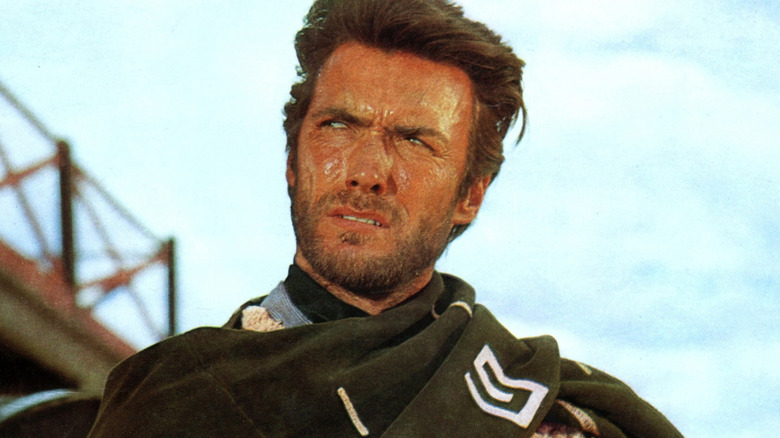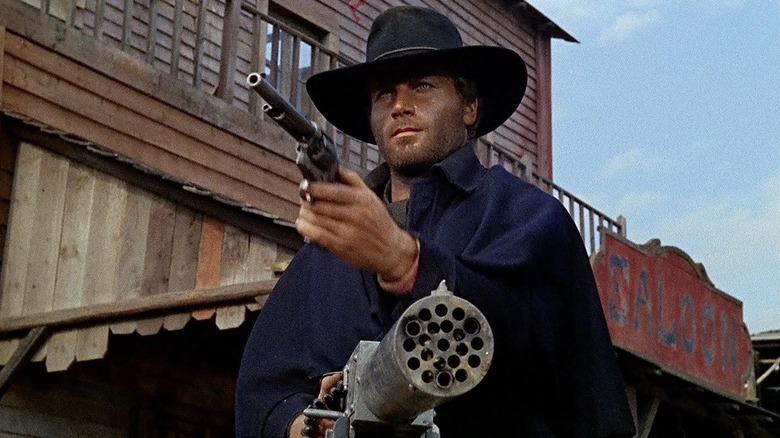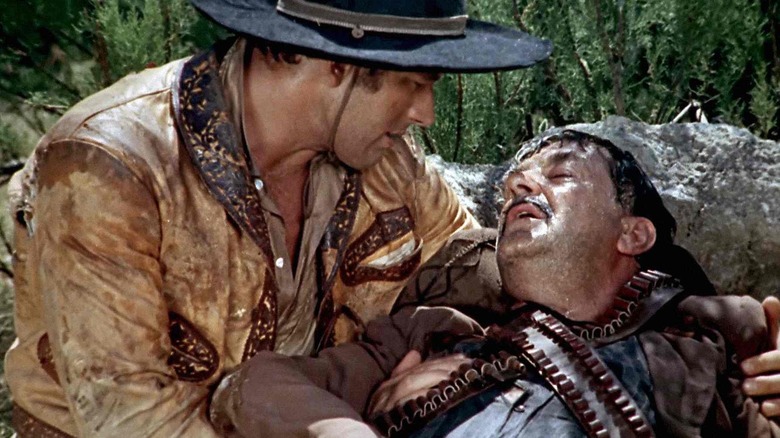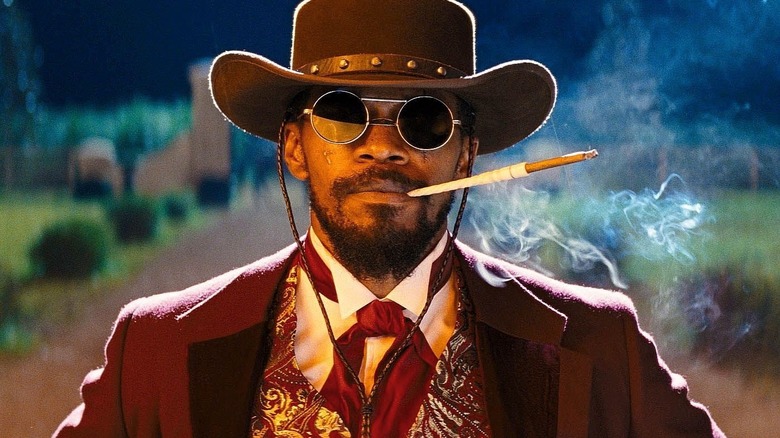What Does Spaghetti Western Actually Mean?
Many of the best Western movies were made a long time ago. The genre goes back almost as far as the medium of film, with one early example being "The Great Train Robbery," a short that was released way back in 1903. Generally, a Western is a film set in the American West, but it's more than that. These movies embody the spirit of the American frontier during a time of westward territorial expansion. Westerns typically feature cowboys, bandits, Native Americans, and the iconic vistas of the American Southwest.
Like any genre, there are subgenres, and one of the most popular is the so-called Spaghetti Western. This is a more specific type of Western film, but the name is certainly odd. After all, what does Spaghetti have to do with cowboys out on the range? Nothing, of course, but the name doesn't refer to a film's content — it's more concerned with how it is made. For a movie to be considered a Spaghetti Western, it's not even filmed in the United States, despite being set there.
Spaghetti Westerns were filmed in Europe, often for less money than they'd be made for in the States. They got the "spaghetti" label because most were filmed by Italian directors. The most famous is Sergio Leone, who popularized the concept, though he was far from the only filmmaker doing this: More than 600 Spaghetti Westerns were made in the 1960s and 1970s. Some of the most popular ones had terribly low budgets and were shot primarily at Cinecittà Studios in Rome, Italy, with location shooting spread throughout Italy and Spain.
What does Spaghetti Western really mean?
The name of this famous subgenre comes from its Italian origins, but what does it really mean to be a Spaghetti Western? Before the subgenre surfaced, Westerns were made for general American audiences. Prior to 1960, they were incredibly popular in the U.S., but when European filmmakers began putting their unique style into the mix, things changed. Spaghetti Westerns are typically more violent with lots of amoral characters, since they were not bound by the constraints of Hollywood's Hays Code Spaghetti Westerns eschewed the conventions of previous Hollywood-produced fare, allowing for more creativity. Not only were the villains more dastardly, but the heroes were different from Hollywood's standard leading men.
Heroes in Spaghetti Westerns were often unshaven and, well, dirty. They toed the line of what was appropriate in society, and this worked. Gone were the well-groomed, clean-cut heroes like James Stewart's Howard Kemp in "The Naked Spur" and James Dean's Jett Rink in "Giant." They were replaced by the likes of Clint Eastwood's Man with No Name in Sergio Leone's "The Good, the Bad and the Ugly." This marked a significant change to the genre, and filmmakers Stateside took notice – Westerns never went back to the way they were made in the 1950s. Even today, modern Westerns continue the trend of embracing violence, often featuring morally ambiguous characters.
What were some of the first Spaghetti Westerns?
Anyone familiar with the subgenre will tell you that the film that kickstarted the Spaghetti Western craze is Sergio Leone's "A Fistful of Dollars," which came out in 1964. There are some earlier examples, but when you look broadly at the Westerns released during that time, it's hard to overlook this classic. Because of this, most people associate Clint Eastwood with Spaghetti Westerns, and that's not necessarily wrong, as he made several of them. However, it should be noted that Eastwood started out in Hollywood playing a ranch hand in 1956's "Star in the Dust," a straight-up Tinseltown Western.
Eastwood made two more Hollywood Westerns ("The First Traveling Saleslady" and "Ambush at Cimarron Pass") before 1964's "A Fistful of Dollars" took him overseas in his first role as a leading man. Leone and Eastwood shot that film and then knocked out "For a Few Dollars More" and "The Good, the Bad, and the Ugly" in 1965 and 1966, respectively. Eastwood's so-called "Dollars" trilogy is widely considered to be the very best that the Spaghetti Western subgenre has to offer, but there are hundreds of excellent movies that fit the bill.
Other early examples include Leone's "Once Upon a Time in the West" and Sergio Corbucci "Django," an incredibly violent film that inspired Quentin Tarantino's "Django Unchained." Notable Spaghetti Westerns shot before 1964 include Alberto De Martino and Antonio Momplet's "Two Against All," Ricardo Blasco's "Gunfight in the Red Sands," and Joaquin L. Romero Marchent's "Implacable Three," though these aren't as well-known in the United States.
Do they still make Spaghetti Westerns?
Spaghetti Westerns were incredibly popular during their heyday, but their time in the sun came to a close in the late 1970s, largely because an oversaturation of them led to a decline in profits. There's plenty of online debate as to which film is considered the last Spaghetti Western, with little agreement. Some argue that 1978's "China 9, Liberty 37" is the last Spaghetti Western, but, while it was filmed in Europe, it was directed by the American filmmaker Monte Hellman. As such, 1977's "White Fang and the Big Kid" (shot in Italy and helmed by the Italian Vito Bruschini) is arguably the last true Spaghetti Western, though it's not as violent as the films of the 1960s.
While there aren't any Spaghetti Westerns being made these days, the impact of European filmmakers on the Western genre, as well as Hollywood films in general, is undeniable. "The movie that made me consider filmmaking, the movie that showed me how a director does what he does, how a director can control a movie through his camera, is 'Once Upon a Time in the West,'" Quentin Tarantino wrote in an op-ed for The Spectator. "It was almost like a film school in a movie. It really illustrated how to make an impact as a filmmaker. How to give your work a signature. I found myself completely fascinated, thinking: 'That's how you do it.' It ended up creating an aesthetic in my mind."
Tarantino's movies "Django Unchained" and "The Hateful Eight" exist because of the influence that Spaghetti Westerns had on a generation of filmmakers, and there are plenty of other examples. The shockingly violent "Bone Tomahawk" is one, as are the Oscar-winners "There Will Be Blood" and "No Country for Old Men." With Hollywood's Hays Code no longer an issue for filmmakers looking to create something raw and real, the circumstances that led to the creation of Spaghetti Westerns have changed, but their legacy lives on through the filmmakers that this subgenre inspired.



